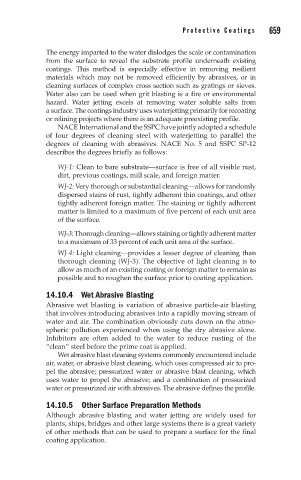Page 705 - Corrosion Engineering Principles and Practice
P. 705
658 C h a p t e r 1 4 P r o t e c t i v e C o a t i n g s 659
The energy imparted to the water dislodges the scale or contamination
from the surface to reveal the substrate profile underneath existing
coatings. This method is especially effective in removing resilient
materials which may not be removed efficiently by abrasives, or in
cleaning surfaces of complex cross section such as gratings or sieves.
Water also can be used when grit blasting is a fire or environmental
hazard. Water jetting excels at removing water soluble salts from
a surface. The coatings industry uses waterjetting primarily for recoating
or relining projects where there is an adequate preexisting profile.
NACE International and the SSPC have jointly adopted a schedule
of four degrees of cleaning steel with waterjetting to parallel the
degrees of cleaning with abrasives. NACE No. 5 and SSPC SP-12
describes the degrees briefly as follows:
WJ-1: Clean to bare substrate—surface is free of all visible rust,
dirt, previous coatings, mill scale, and foreign matter.
WJ-2: Very thorough or substantial cleaning—allows for randomly
dispersed stains of rust, tightly adherent thin coatings, and other
tightly adherent foreign matter. The staining or tightly adherent
matter is limited to a maximum of five percent of each unit area
of the surface.
WJ-3: Thorough cleaning—allows staining or tightly adherent matter
to a maximum of 33 percent of each unit area of the surface.
WJ-4: Light cleaning—provides a lesser degree of cleaning than
thorough cleaning (WJ-3). The objective of light cleaning is to
allow as much of an existing coating or foreign matter to remain as
possible and to roughen the surface prior to coating application.
14.10.4 Wet Abrasive Blasting
Abrasive wet blasting is variation of abrasive particle-air blasting
that involves introducing abrasives into a rapidly moving stream of
water and air. The combination obviously cuts down on the atmo-
spheric pollution experienced when using the dry abrasive alone.
Inhibitors are often added to the water to reduce rusting of the
“clean” steel before the prime coat is applied.
Wet abrasive blast cleaning systems commonly encountered include
air, water, or abrasive blast cleaning, which uses compressed air to pro-
pel the abrasive; pressurized water or abrasive blast cleaning, which
uses water to propel the abrasive; and a combination of pressurized
water or pressurized air with abrasives. The abrasive defines the profile.
14.10.5 Other Surface Preparation Methods
Although abrasive blasting and water jetting are widely used for
plants, ships, bridges and other large systems there is a great variety
of other methods that can be used to prepare a surface for the final
coating application.

